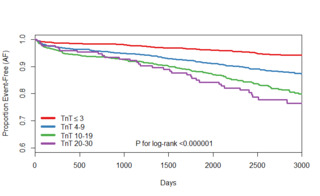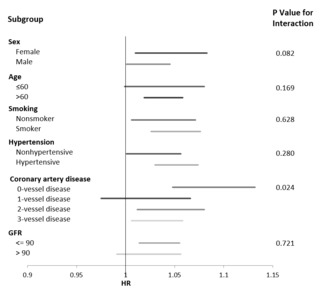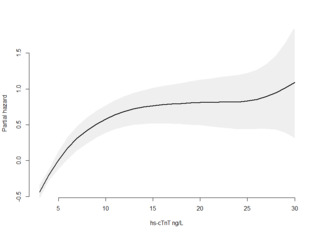Systemic Cardiac Troponin T Associated With Incident Atrial Fibrillation Among Patients With Suspected Stable Angina Pectoris
| dc.contributor.author | Vavik, Vegard | |
| dc.contributor.author | Pedersen, Eva Ringdal | |
| dc.contributor.author | Svingen, Gard Frodahl Tveitevåg | |
| dc.contributor.author | Solheim, Eivind | |
| dc.contributor.author | Aakre, Kristin Moberg | |
| dc.contributor.author | Tell, Grethe S. | |
| dc.contributor.author | Nygård, Ottar | |
| dc.contributor.author | Vikenes, Kjell | |
| dc.date.accessioned | 2021-07-13T08:37:16Z | |
| dc.date.available | 2021-07-13T08:37:16Z | |
| dc.date.created | 2021-01-07T11:43:11Z | |
| dc.date.issued | 2020 | |
| dc.identifier.issn | 0002-9149 | |
| dc.identifier.uri | https://hdl.handle.net/11250/2764245 | |
| dc.description.abstract | Higher concentrations of cardiac troponin T are associated with coronary artery disease (CAD) and adverse cardiovascular prognosis. The relation with incident atrial fibrillation (AF) is less explored. We studied this association among 3,568 patients evaluated with coronary angiography for stable angina pectoris without previous history of AF. The prospective association between high-sensitivity cardiac troponin T (hs-cTnT) categories (≤3 ng/L; n = 1,694, 4-9; n = 1,085, 10 to 19; n = 614 and 20 to 30; n = 175) and incident AF and interactions with the extent of CAD were studied by Kaplan-Meier plots and Cox regression. Risk prediction improvements were assessed by receiver operating characteristic area under the curve (ROC-AUC) analyses. During median (25 to 75 percentile) 7.3 (6.3 to 8.6) years of follow-up 412 (11.5%) were diagnosed with AF. In a Cox model adjusted for age, gender, body mass index, hypertension, diabetes mellitus, smoking, estimated glomerular filtration rate, and left ventricular ejection fraction, hazard ratios (HRs) (95% confidence intervals [CIs]) were 1.53 (1.16 to 2.03), 2.03 (1.49 to 2.78), and 2.15 (1.40 to 3.31) when comparing the second, third, and fourth to the first hs-cTnT group, respectively (P for trend <0.000001). The strongest association between hs-cTnT levels and incident AF was found among patients without obstructive CAD (Pint = 0.024) and adding hs-cTnT to established AF risk factors improved risk classification slightly (ΔROC 0.006, p = 0.044). In conclusion, in patients with suspected stable angina higher levels of hs-cTnT predicted increased risk of incident AF. This was most pronounced in patients without obstructive CAD suggesting an association not mediated by coronary disease. | en_US |
| dc.language.iso | eng | en_US |
| dc.publisher | Elsevier | en_US |
| dc.rights | Attribution-NonCommercial-NoDerivatives 4.0 Internasjonal | * |
| dc.rights.uri | http://creativecommons.org/licenses/by-nc-nd/4.0/deed.no | * |
| dc.title | Systemic Cardiac Troponin T Associated With Incident Atrial Fibrillation Among Patients With Suspected Stable Angina Pectoris | en_US |
| dc.type | Journal article | en_US |
| dc.type | Peer reviewed | en_US |
| dc.description.version | acceptedVersion | en_US |
| dc.rights.holder | Copyright 2020 Elsevier | en_US |
| cristin.ispublished | true | |
| cristin.fulltext | postprint | |
| cristin.fulltext | postprint | |
| cristin.fulltext | postprint | |
| cristin.fulltext | postprint | |
| cristin.fulltext | postprint | |
| cristin.fulltext | postprint | |
| cristin.fulltext | postprint | |
| cristin.fulltext | postprint | |
| cristin.fulltext | postprint | |
| cristin.fulltext | postprint | |
| cristin.qualitycode | 1 | |
| dc.identifier.doi | https://doi.org/10.1016/j.amjcard.2020.03.036 | |
| dc.identifier.cristin | 1866925 | |
| dc.source.journal | American Journal of Cardiology | en_US |
| dc.source.pagenumber | 30-35 | en_US |
| dc.identifier.citation | American Journal of Cardiology. 2020, 127, 30-35. | en_US |
| dc.source.volume | 127 | en_US |
Tilhørende fil(er)
Denne innførselen finnes i følgende samling(er)
-
Department of Clinical Science [2294]
-
Registrations from Cristin [9489]




